View basket (0 items $0.00)
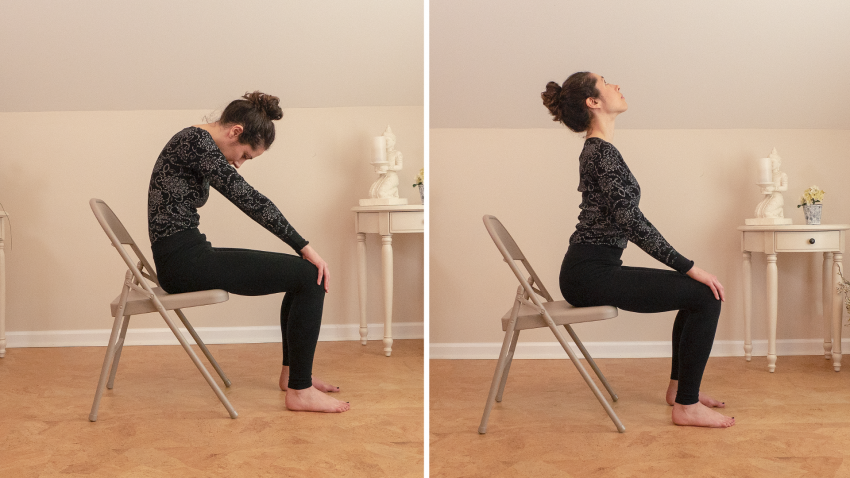
A Chair Yoga Sequence for Arthritis: Increase Mobility and Decrease Pain
Creaky joints, stiffness, pain, difficulty doing the most mundane of tasks, never mind those that are physically challenging and exhilarating. These experiences characterize arthritis, “a broad range of over 100 diseases … mainly involving pain around the joints” (webmd.com).
The two most common types are rheumatoid arthritis and osteoarthritis. The former is an autoimmune disease, and the latter involves a gradual thinning and diminishment of synovial fluid.
In one way, we’re like the Tinman in The Wizard of Oz; we need a unique substance for our joints to move, the synovial fluid, which cushions joints and allows for smooth, pain-free movement. Less of it means that arthritis symptoms can set in. Gentle movement through a joint's range of motion, along with other components of physical fitness (such as strengthening and cardiovascular work), can reduce those symptoms, and can contribute to preventing the condition altogether.
But the symptoms themselves can make patients understandably reluctant to be physically active, thus, a tricky catch-22. Allowance for individual modifications and rest when needed can help. Yoga, among all modern physical fitness forms, allows for modifications and rest. Practicing yoga asana in a chair offers even more accessibility. Any arthritis patient can use it to help reduce pain and increase mobility.
Let’s look at a chair yoga sequence that can do just that. Om Shanti!
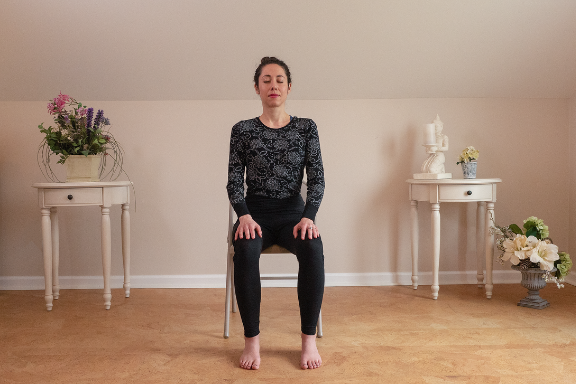 Before Beginning a Chair Yoga Sequence
Before Beginning a Chair Yoga Sequence
1. Take a moment to close your eyes (if that’s comfortable for you) and draw your attention inward.
2. Inch your seat out to the front half of your chair. Place your palms on your thighs, up or down, or in another mudra (hand position), whatever feels best for you.
3. Plant your feet firmly at hip-distance apart, your ankles right under your knees.
4. With every breath in, try to lengthen up a bit more through your spine. With every breath out, try to soften around that length.
5. After ten full breaths, or whenever you feel ready, softly blink your eyes open.
The following suggestions for several repetitions are just that, suggestions; take more or less, as feels best for your body, mind, and spirit today. In the same way, make movements and stretches as big or small as feels right. Move and transition into poses at the speed that feels best for you today.
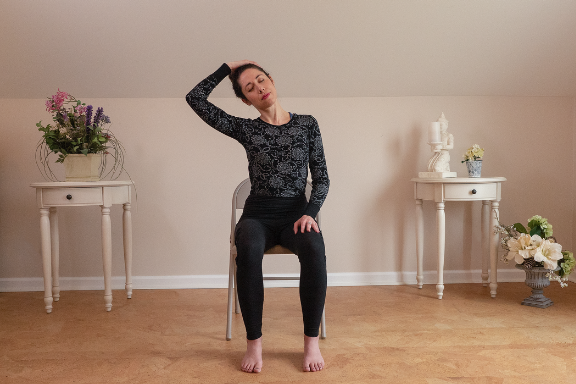 Neck Movement
Neck Movement
1. Let your right ear drop to your right shoulder, then swing your head forward so your that chin comes to your chest, and then let it keep swinging so that your left ear comes to your left shoulder. Swing it through the center back over to the other side. Take five swings in each direction.
2. Keep your right ear to your right shoulder. Extend your right arm up overhead, bend your right elbow, and place your right hand gently over your left ear.
3. Don’t pull with your right hand, as that could cause muscle strain or pull. The weight of your hand should be enough to encourage a gentle stretch on the left side of your neck.
4. Do the same stretch on the other side.
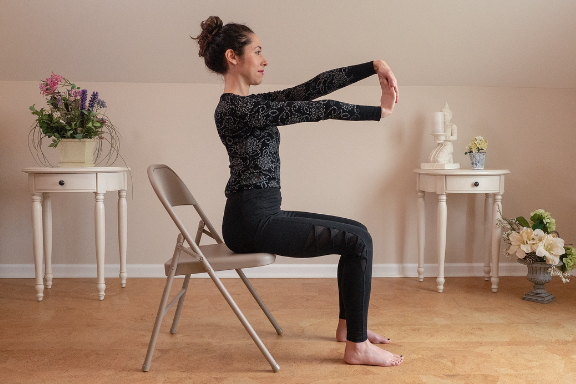 Shoulder Rolls and Hand Movement/Stretch
Shoulder Rolls and Hand Movement/Stretch
1. Roll your shoulders in circles, five rotations in each direction. Do the same with your wrists. Imagine big rolling desert tumbleweeds or a spinning water wheel.
2. Open and close your hands two times, and then give them each a few good shakes.
3. Then extend your right arm out and up, extending your fingers right up to the sky, as if signaling “stop!”
4. Take the left hand’s palm to that right hand’s palm, fingers pointing downward (so that both sets of fingertips touch the opposite hand’s wrist).
5. Hold for five full breaths, shake it out, and do the same on the other side (ending with a shake).
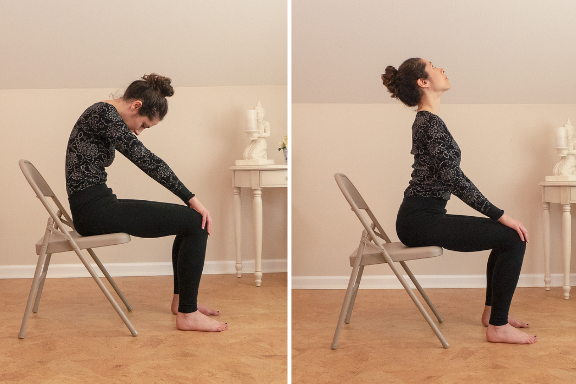 Seated Cat/Cow Yoga Flow and Torso Circle
Seated Cat/Cow Yoga Flow and Torso Circle
1. Lift your heart to the sky on an inhalation, creating a slight backbend shape. Let your head follow the movement as it will.
2. Curve inwards from your navel and make a c-shape in your spine as you breathe out, again letting your head follow the movement as it will.
3. Take five rounds.
4. Add a side-to-side dimension to the movement by taking your torso in circles. Do five circles, and then switch direction. Then take a moment in stillness to breathe and notice how your body feels.
 Chair Sun Salutations
Chair Sun Salutations
1. Sitting in a chair, reach your arms out and up (or forward and up, if you're in a cramped space) to meet the palms up overhead—Urdhva Hastasana (Upward Hands Pose).
2. Look up at your hands, if it doesn’t bother your neck, to change your gaze and perspective.
3. Reverse that movement, taking arms out and down (or through the heart center and down) to then fold forward at the hips.
4. Take a full breath out, letting your head and neck release.
5. Breathe in to lift your torso up slightly, and then let it release fully forward again as you breathe out.
6. To finish the seated Sun Salutation, breath in to raise your torso back up to the sky, your arms following to meet your palms up overhead. Look up again, as long as it doesn’t cause discomfort in your neck.
7. Move your hands back through heart center.
8. Practice four more rounds. Feel free to add on any twists, side bends, or other movements that feel good for you.
9. Breathe in stillness for a couple of breaths, feeling the resonance of movement throughout you.
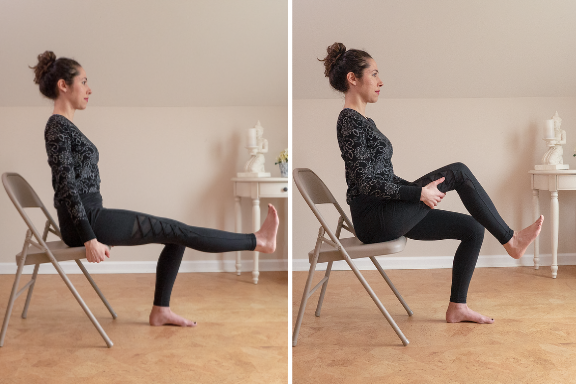 Chair Yoga Leg Sequence
Chair Yoga Leg Sequence
-
Lift your right thigh a few inches, and then straighten your knee, extending your heel forward. Then drop your leg back down.
-
Do the same on your left leg. Repeat four more times on each leg.
-
On the last lift, keep your thigh lifted and reach down and clasp your hands underneath it. Roll the same ankle five times in each direction.
-
Then cross your ankle just above your left knee to create a “figure-4” shape. If you aren’t feeling all that much sensation, you can take the same-side hand on the inside of the thigh and apply gentle pressure.
-
Hold for five breaths, and take the stretch on the other side.
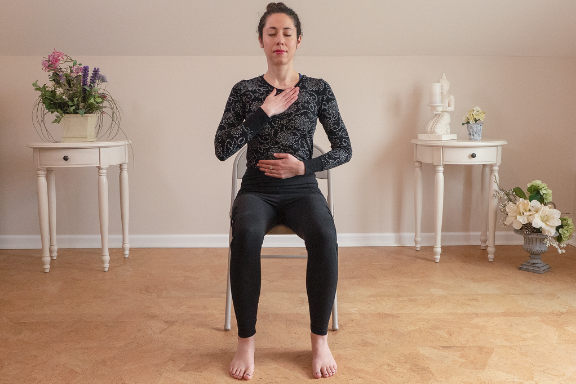 Closing Meditation/Mindful Moment
Closing Meditation/Mindful Moment
-
Take any other movements or stretches that feel right for you. Then close your eyes, if that’s comfortable, and refocus on your breath.
-
Think of a color that makes you feel energized.
-
Imagine a small circle of that color at your heart center moving outwards— all the way out through fingertips, toes, the top of your head, and every other periphery of your body.
-
After five full breaths of this color all throughout you, do the whole process with a color that makes you feel calm.
-
When you’re ready, softly flutter your eyes open.
Know that it's possible for you to experience today with more mobility and less pain!
Yoga For Every Body: How to Adapt Poses for Different Situations and Conditions and Purposes a course from YogaUOnline and Olga Kabel.
 Kathryn Boland is an RCYT and R-DMT (Registered Dance/Movement Therapist). She is originally from Rhode Island, attended George Washington University (Washington, DC) for an undergraduate degree in Dance (where she first encountered yoga), and Lesley University for an MA in Clinical Mental Health Counseling, Expressive Therapies: Dance/Movement Therapy. She has taught yoga to diverse populations in various locations. As a dancer, she has always loved to keep moving and flowing in practicing more active Vinyasa-style forms. Her interests have recently evolved to include Yin and therapeutic yoga, and aligning those forms with Laban Movement Analysis to serve the needs of various groups (such as Alzheimer’s Disease patients, children diagnosed with ADHD, PTSD-afflicted veterans - all of which are demographically expanding). She believes in finding the opportunity within every adversity, and doing all that she can to help others live with a bit more breath and flow!
Kathryn Boland is an RCYT and R-DMT (Registered Dance/Movement Therapist). She is originally from Rhode Island, attended George Washington University (Washington, DC) for an undergraduate degree in Dance (where she first encountered yoga), and Lesley University for an MA in Clinical Mental Health Counseling, Expressive Therapies: Dance/Movement Therapy. She has taught yoga to diverse populations in various locations. As a dancer, she has always loved to keep moving and flowing in practicing more active Vinyasa-style forms. Her interests have recently evolved to include Yin and therapeutic yoga, and aligning those forms with Laban Movement Analysis to serve the needs of various groups (such as Alzheimer’s Disease patients, children diagnosed with ADHD, PTSD-afflicted veterans - all of which are demographically expanding). She believes in finding the opportunity within every adversity, and doing all that she can to help others live with a bit more breath and flow!
Featured Courses








